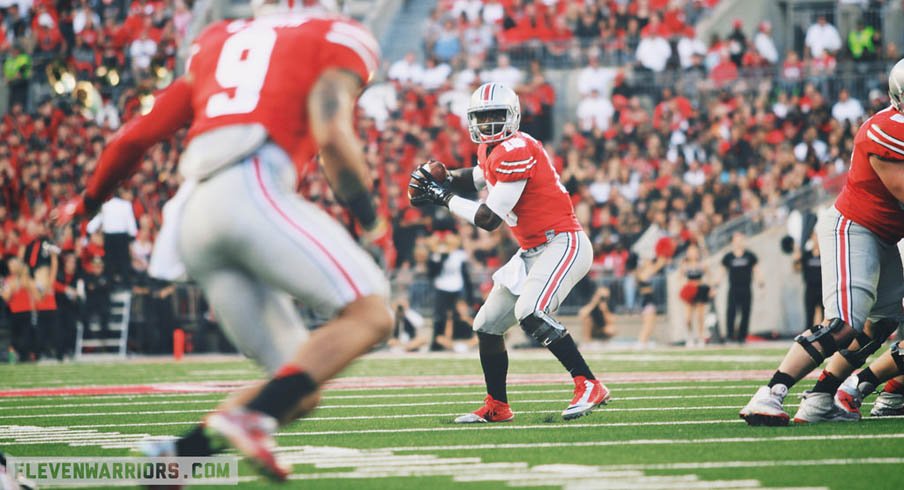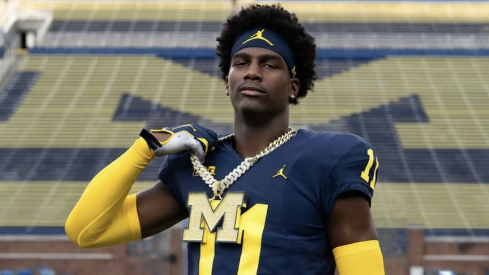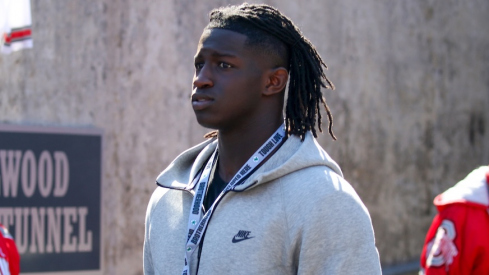Three explosive plays from Cincinnati marred an otherwise stellar performance from Ohio State against a solid Bearcat squad. The Buckeye offense had a near record-breaking game by adjusting to the techniques Virginia Tech used to stifle the Ohio State offense. Urban Meyer and Tom Herman have used the hard lessons learned against the Hokies to their advantage, resulting in a more cohesive Buckeye attack.
Defensively, although allowing three long touchdowns cannot be ignored, good growth was evidenced in implementing a more aggressive scheme with a young back seven against a good passing offense. All three plays resulted from correctable breakdowns. Those plays aside, the Buckeyes did not allow sustained drives, played more fundamentally sound football, and have an identity from which to improve.
As the Old Saying Goes . . .
A well-worn football expression is live by the blitz, die by the blitz. The point is that while a blitz-heavy team will create negative plays it is also exposed to allowing home runs.
Ohio State under Chris Ash is not a blitz-heavy team. But Ash's press cover 4 scheme can expose a defense in much the same way because the pattern-matching framework results in defensive backs often locking in man coverage, particularly on vertical routes.
Cincinnati's coaches know that the Buckeyes are a cover 4 team. So they dialed up plays to combat that defense. All three big pass plays resulted from smart calls by the Bearcats, mistakes by Ohio State, and nice execution by Cincinnati's wide receivers.
- First explosive pass: The number 2 (inside receiver) ran a vertical route, leaving safety Von Bell in man coverage. Bell had decent position. But Cincinnati's wide receiver made a great catch off Bell's helmet and then Bell missed the tackle. According to Ash:
Vonn’s just got to be on top of the receiver and make a play. When you do what we do, you put yourself in one-on-one situations and you’ve got to win those one-on-one battles.
- Second explosive pass: Cincinnati ran a cover 4 beater -- Mills. With Mills, the inside receiver runs a curl or in while the outside receiver runs a post behind.

Prior to the game, Kyle diagrammed precisely how this attacks cover 4 principles. The in-route holds the safety because he sees number 2 release vertically. This puts the corner in man coverage against the outside route. But a cover 4 corner uses outside leverage, leaving him at a disadvantage.
On Saturday, the Buckeye safety and walkout linebacker jumped the in-route, leaving corner Eli Apple alone against the post. Apple got beat inside, leading to the touchdown.
As Meyer conceded Monday, the Buckeyes should not have been in cover 4 when the Bearcats needed to go over 80 yards in 40 seconds. But the Buckeyes were in the coverage, and the Bearcats had the perfect call. Mills is a time-tested concept and Cincinnati made the right call at the right time.
- Third explosive pass: Cincinnati dialed up a constraint play. The inside receiver faked a bubble screen while the outside receiver ran a slant. To that point, Buckeye corner Doran Grant made several nice plays against wide receiver screens.
But with cover 4, the safety and walkout linebacker are responsible for the screen while the corner must remain with the outside receiver. Cincinnati caught Grant locking on the inside receiver, freeing the slant for the easy score.
As Ash stated:
His [Grant's] was a discipline error,” Ash said. “He didn't bust an assignment, what he did is he put his eyes in the wrong spot. They had run so many bubbles by (MeKale McKay), and (Grant) actually made a play or two that he wasn't necessarily supposed to on the bubbles. Well, they run a bubble and he had his eyes in the backfield and cut his guy loose. It was a discipline error, and those things are easy fixes."
So it was a coverage breakdown but also an effective call by the Bearcats. Ironically, the Buckeyes later returned the favor by faking a flash screen that led to a wide-open Dontre Wilson touchdown.
Overshadowed
Take away those three plays and, according to Scout.com's Jeff Svoboda, the Buckeyes only gave up 131 yards on Cincinnati’s other 30 passes, held UC to 4 of 11 on third down and allowed just 47 yards of offense on the Bearcats’ last four drives. In fact, Cincinnati's other touchdown was also set up by an explosive play, when Gunner Kiel gained 19 yards on a zone read after defensive end Joey Bosa failed to account for the quarterback.
That is not to white-wash away the explosive plays or absolve the Ohio State defense from needed-improvements. Whenever the Buckeyes got pressure on Kiel he did not step into his throws and the ball would sail, but the Buckeye pass rush was inconsistent. Ohio State clearly misses Noah Spence.
And the Buckeyes must self-evidently continue to improve in their man coverage skills and execution in Ash's cover 4 scheme. As an acknowledgement of the still-needed growth, after Cincinnati's last touchdown the Buckeyes used bail techniques from press coverage to protect against explosive plays.
But unlike last year, the Buckeye defense has an identity. This permits the coaching staff to make minor adjustments such as changing techniques, identify errors and correct them. Last year, by contrast, Ohio State would cycle through coverage schemes, leading to weekly breakdowns.
This year's defense also already exhibits far better fundamentals. The best example is one area the Buckeyes were largely successful against Cincinnati -- defending the wide receiver screen game. Buckeye defenders played screens correctly, flowed to the football and tackled.
In sum, the problems are not systemic but correctable individual breakdowns. The Buckeyes are no longer being outflanked by formation or exhibiting wholesale coverage breakdowns.
And Ohio State is making this change with a very young back seven. There is no better example then true freshman Raekwon McMillan playing nearly the entire game at Mike linebacker.
The Buckeye defense had the far tougher task Saturday, facing an efficient Bearcat passing game. Although breakdowns such that occurred Saturday will undoubtedly happen again this season, the Ohio State defense remains on the right trajectory. The Buckeye defense faces another stout offense Saturday in Maryland. The Buckeye goal must be limiting such explosive plays.
Growing in the Shadow of the Bear
The Buckeyes' offensive performance against Cincinnati may not have happened without the failures against Virginia Tech's bear defense. In response to that game, the Buckeyes have made three significant adjustments to ensure another opponent cannot take Ohio State out of their offense. The result has been a more systemic, coherent offensive framework that is featuring players in advantageous situations.
As Meyer discussed in his post-game press conference, Ohio State's offense revolves around the inside run game. More specifically, the Buckeyes' base play has been tight zone to an offset back attacking the backside A gap.
The bear limits this play because, by covering up the interior three linemen, the offensive line cannot establish double teams and the back lacks a bubble to attack. Against Virginia Tech, without the base run game the rest of the offense quickly sputtered.
Meyer and Herman remedied that deficiency. The Buckeyes still feature tight zone. But they also run it from the pistol towards the tight end (rather then open side). The line blocks inside zone away from the strength. So if a defense aligns in a bear, the offensive line blocks those interior linemen down and the back can cut to the C gap. Ohio State is also running far more power from the same tight end pistol formation. Both provide the Buckeye run game more flexibility against different fronts.
Additionally, Meyer and Herman have implemented a simple check to a bear beater whenever a defense aligns in the front. The play is a counter trap. The guard rides the three technique out, while the tackle traps the inside linebacker. The counter fake holds the outside linebacker.
In an attempt to slow the Buckeyes down in the third quarter the Bearcats jumped to a bear front. But as Meyer disclosed, the Buckeyes were so effective running the trap play that Cincinnati had no choice but to abandon the front.
What Else You Got?
In Meyer's first two years he and Herman's response to teams overplaying the inside run game was utilizing Braxton Miller as the horizontal threat. The Buckeye coaching staff tried the same formula against the Hokies.
But Barrett is not the same runner and Meyer and Herman discovered that Bud Foster wanted Barrett running the football -- as opposed to Buckeye skill players such as Dontre Wilson attacking the edge.
Meyer and Herman have subsequently ensured that Ohio State does not lose its horizontal attack. Part of that is establishing that the Buckeyes' inside run game, which prevents a team from concentrating on the edge.
But the coaching staff has also better linked the inside and outside game. For instance, the Buckeyes frequently send their H in jet motion to threaten the defense with a touch pass. From there, Ohio State can either run inside or hit the touch sweep.
Meyer and Herman have found such a threat better constrains the defense then Barrett in the zone read. On Saturday the Buckeyes also frequently ran a half bootleg that looked identical to power, getting Barrett to the edge behind the pulling guard with a curl-flat read and an easy pass to the tight end.
In sum, Meyer and Herman have done a nice job making their inside and outside plays look alike, preventing a defense from overly focusing upon either.
Can't Cover them All
The third -- and related -- aspect to this approach is punishing teams that want to utilize aggressive coverages. The primary method is a swing pass screen to the running back.
The play strains a defense in man coverage. A linebacker who has run responsibilities must sprint to the flat to match a Buckeye tailback. The play was wide open against Virginia Tech. But the Buckeyes did not attempt it until it was too late.
Since, however, the Buckeyes have utilized the look to great success. Cincinnati had little chance of accounting for Ezekiel Elliot, who made several critical catches and yards after the catch.
Ohio State has also done a better job attacking the middle of the field with the passing game. Perhaps the most successful example was follow-pivot against the Bearcats' cover 4. By creating a hi-lo on the safety the Buckeyes opened several chunk plays, most notably Devin Smith's first touchdown catch.
First Principles
None of this matters, of course, without execution. This begins with the offensive line, who put forth their best performance this season. The Buckeyes created movement in the run game and handled the Bearcats' various stunts and twists. It is easy to belittle the competition, but the offensive line faced a similar talent level against Navy and struggled with the Midshipman's games up front. So Saturday represented marked technical improvement.
Elliot also deserves significant credit, gaining 111 yards after contact. And JT Barrett played his best game and continues to improve each week. With such improvement the coaching staff feels more comfortable implementing a comprehensive game plan.
But the Buckeye offense as a whole is functioning as a much higher level because the Ohio State coaching staff successfully responded to the techniques defenses were using to slow the Buckeyes and are putting their players in a position where they can best succeed.
So long as the Buckeyes can continue to run the football inside and then threaten the edge, Barrett should have opportunities to make plays in the pass game and the Ohio State offense will have further opportunities for success.


